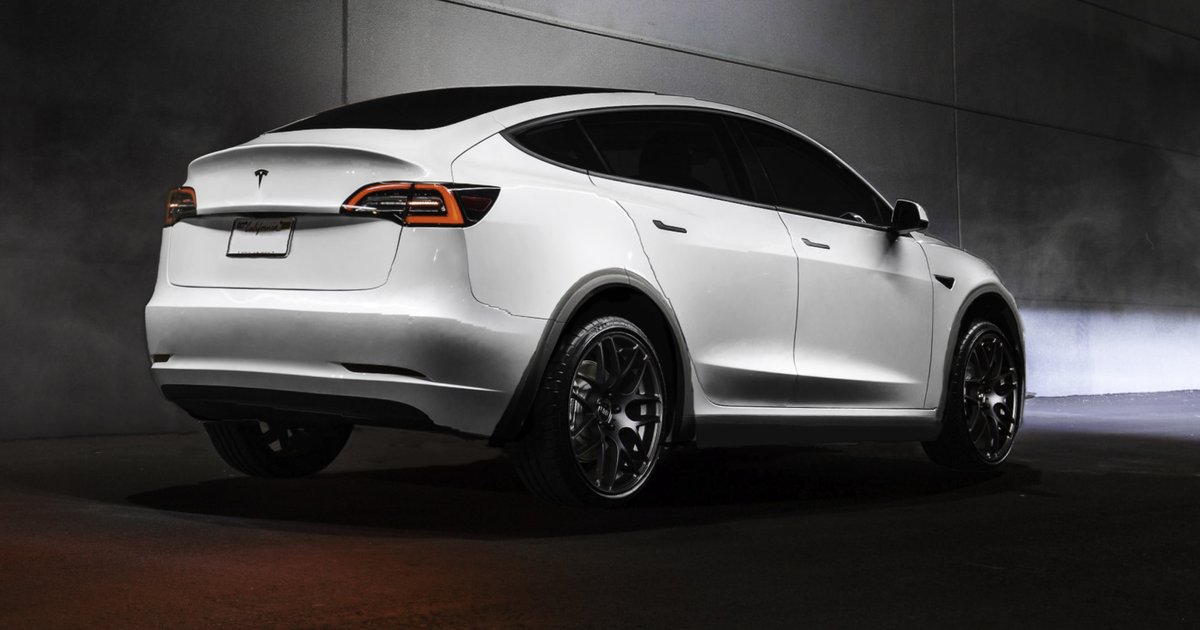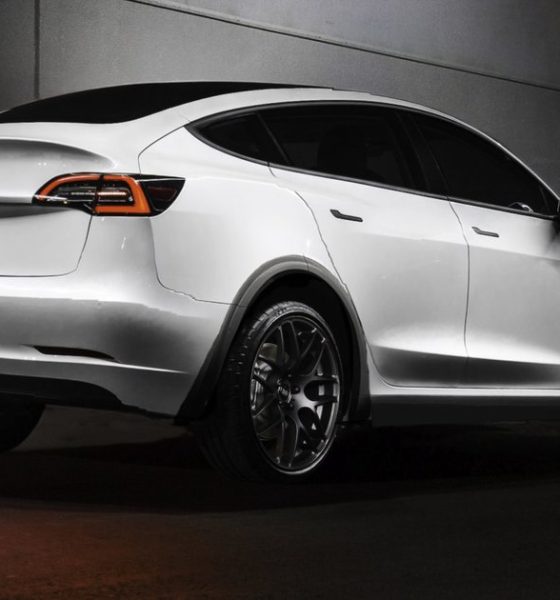

News
Tesla Model Y will awaken Elon Musk’s ‘Alien Dreadnaught’ factory
Elon Musk’s “Alien Dreadnought” factory could see a second coming when Tesla Model Y is ready for production ramp, thanks to recent advancements in computer vision.
Before Tesla started the Model 3 ramp, Elon Musk described his vision for a hyper-automated factory that he described as “the machine that builds the machine.” Addressing investors, Musk revealed that the project’s code name was the “Alien Dreadnought,” a reference to the futuristic spacecraft usually utilized by extraterrestrials in sci-fi movies. Musk planned to use the Alien Dreadnought for the Model 3 ramp, and he expected the automated factory to be operational by 2018.
This timeline proved to be too optimistic, with the Tesla CEO later admitting that he had been far too enthusiastic with the Model 3 production line’s automation. “Humans are underrated,” Musk admitted in an interview with CBS. Ultimately, it was a combination of traditional human work and non-Alien-Dreadnought type of automation that became a breakthrough for the Model 3 ramp. Tesla has since gotten the hang of Model 3 production, with the company producing enough vehicles for the US, as well as Europe and China (at least for selected regions) today.

According to Ryan Kottenstette, who serves as the CEO of Cape Analytics, a group that conducts computer vision research, the challenges Tesla faced with the Model 3 ramp were caused by the limitations of robotic vision. Kottenstette notes that the robots Tesla utilized in the Model 3 line simply could not deal with unexpected events in the production process, such as different orientations of nuts and bolts, or complicated maneuvering between the car frame.
Musk mentioned one of these challenges in the Q1 2018 earnings call when he described a machine he fondly called “Flufferbot,” which had a lot of difficulties scooping out fiberglass mats (or “fluff” as Musk described it) for the Model 3 battery pack. Musk stated that Flufferbot eventually lost its job because it became evident that scooping out “fluff” is far easier when done with human hands.

Kottenstette argues that computer vision has progressed significantly in recent years, with approaches such as GANs (Generative Adversarial Networks) and unsupervised learning expanding the envelope of computer vision in terms of applications, robustness, and reliability. These advancements can help address some of the challenges faced by Tesla during the days of the Model 3 ramp. Coupled with Tesla’s proficiency in tech, and augmented by the company’s robust AI team, these new computer vision approaches can be leveraged to allow another attempt at Elon Musk’s “Alien Dreadnought” factory.
An opportunity is actually preseting itself for Tesla, as the company is scheduled to unveil the Model Y SUV next week. Just like the Model 3, the Model Y is a high-volume, mass-market vehicle, with Elon Musk expecting demand for the vehicle to go as high as 1 million units per year. Unlike the Model S, X, and Model 3, Tesla is set to start the initial production of the Model Y at Gigafactory 1 in Nevada, which means that the company can design and set up the SUV’s production lines from a blank slate. Thanks to the Model Y, Elon Musk’s “Alien Dreadnought” factory might end up being closer than we think.

News
Tesla FSD fleet is nearing 7 billion total miles, including 2.5 billion city miles
As can be seen on Tesla’s official FSD webpage, vehicles equipped with the system have now navigated over 6.99 billion miles.

Tesla’s Full Self-Driving (Supervised) fleet is closing in on almost 7 billion total miles driven, as per data posted by the company on its official FSD webpage.
These figures hint at the massive scale of data fueling Tesla’s rapid FSD improvements, which have been quite notable as of late.
FSD mileage milestones
As can be seen on Tesla’s official FSD webpage, vehicles equipped with the system have now navigated over 6.99 billion miles. Tesla owner and avid FSD tester Whole Mars Catalog also shared a screenshot indicating that from the nearly 7 billion miles traveled by the FSD fleet, more than 2.5 billion miles were driven inside cities.
City miles are particularly valuable for complex urban scenarios like unprotected turns, pedestrian interactions, and traffic lights. This is also the difference-maker for FSD, as only complex solutions, such as Waymo’s self-driving taxis, operate similarly on inner-city streets. And even then, incidents such as the San Francisco blackouts have proven challenging for sensor-rich vehicles like Waymos.
Tesla’s data edge
Tesla has a number of advantages in the autonomous vehicle sector, one of which is the size of its fleet and the number of vehicles training FSD on real-world roads. Tesla’s nearly 7 billion FSD miles then allow the company to roll out updates that make its vehicles behave like they are being driven by experienced drivers, even if they are operating on their own.
So notable are Tesla’s improvements to FSD that NVIDIA Director of Robotics Jim Fan, after experiencing FSD v14, noted that the system is the first AI that passes what he described as a “Physical Turing Test.”
“Despite knowing exactly how robot learning works, I still find it magical watching the steering wheel turn by itself. First it feels surreal, next it becomes routine. Then, like the smartphone, taking it away actively hurts. This is how humanity gets rewired and glued to god-like technologies,” Fan wrote in a post on X.
News
Tesla starts showing how FSD will change lives in Europe
Local officials tested the system on narrow country roads and were impressed by FSD’s smooth, human-like driving, with some calling the service a game-changer for everyday life in areas that are far from urban centers.

Tesla has launched Europe’s first public shuttle service using Full Self-Driving (Supervised) in the rural Eifelkreis Bitburg-Prüm region of Germany, demonstrating how the technology can restore independence and mobility for people who struggle with limited transport options.
Local officials tested the system on narrow country roads and were impressed by FSD’s smooth, human-like driving, with some calling the service a game-changer for everyday life in areas that are far from urban centers.
Officials see real impact on rural residents
Arzfeld Mayor Johannes Kuhl and District Administrator Andreas Kruppert personally tested the Tesla shuttle service. This allowed them to see just how well FSD navigated winding lanes and rural roads confidently. Kruppert said, “Autonomous driving sounds like science fiction to many, but we simply see here that it works totally well in rural regions too.” Kuhl, for his part, also noted that FSD “feels like a very experienced driver.”
The pilot complements the area’s “Citizen Bus” program, which provides on-demand rides for elderly residents who can no longer drive themselves. Tesla Europe shared a video of a demonstration of the service, highlighting how FSD gives people their freedom back, even in places where public transport is not as prevalent.
What the Ministry for Economic Affairs and Transport says
Rhineland-Palatinate’s Minister Daniela Schmitt supported the project, praising the collaboration that made this “first of its kind in Europe” possible. As per the ministry, the rural rollout for the service shows FSD’s potential beyond major cities, and it delivers tangible benefits like grocery runs, doctor visits, and social connections for isolated residents.
“Reliable and flexible mobility is especially vital in rural areas. With the launch of a shuttle service using self-driving vehicles (FSD supervised) by Tesla in the Eifelkreis Bitburg-Prüm, an innovative pilot project is now getting underway that complements local community bus services. It is the first project of its kind in Europe.
“The result is a real gain for rural mobility: greater accessibility, more flexibility and tangible benefits for everyday life. A strong signal for innovation, cooperation and future-oriented mobility beyond urban centers,” the ministry wrote in a LinkedIn post.
News
Tesla China quietly posts Robotaxi-related job listing
Tesla China is currently seeking a Low Voltage Electrical Engineer to work on circuit board design for the company’s autonomous vehicles.

Tesla has posted a new job listing in Shanghai explicitly tied to its Robotaxi program, fueling speculation that the company is preparing to launch its dedicated autonomous ride-hailing service in China.
As noted in the listing, Tesla China is currently seeking a Low Voltage Electrical Engineer to work on circuit board design for the company’s autonomous vehicles.
Robotaxi-specific role
The listing, which was shared on social media platform X by industry watcher @tslaming, suggested that Tesla China is looking to fill the role urgently. The job listing itself specifically mentions that the person hired for the role will be working on the Low Voltage Hardware team, which would design the circuit boards that would serve as the nervous system of the Robotaxi.
Key tasks for the role, as indicated in the job listing, include collaboration with PCB layout, firmware, mechanical, program management, and validation teams, among other responsibilities. The role is based in Shanghai.
China Robotaxi launch
China represents a massive potential market for robotaxis, with its dense urban centers and supportive policies in select cities. Tesla has limited permission to roll out FSD in the country, though despite this, its vehicles have been hailed as among the best in the market when it comes to autonomous features. So far, at least, it appears that China supports Tesla’s FSD and Robotaxi rollout.
This was hinted at in November, when Tesla brought the Cybercab to the 8th China International Import Expo (CIIE) in Shanghai, marking the first time that the autonomous two-seater was brought to the Asia-Pacific region. The vehicle, despite not having a release date in China, received a significant amount of interest among the event’s attendees.








